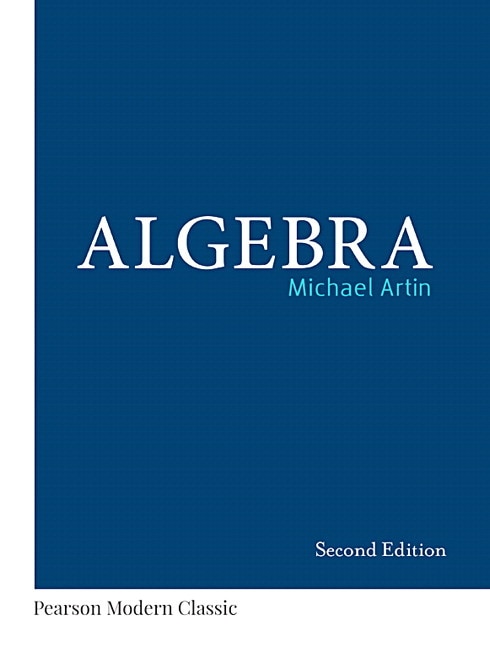
Algebra (Classic Version), 2nd edition
- Michael Artin

- Find it fast
Quickly navigate your eTextbook with search
- Stay organized
Access all your eTextbooks in one place
- Easily continue access
Keep learning with auto-renew
Algebra, 2nd Edition is ideal for an honors undergraduate or introductory graduate course. This revision of the classic text incorporates 20 years of feedback and the author's own teaching experience. It discusses concrete topics of algebra in greater detail than most, preparing you for the more abstract concepts; linear algebra is tightly integrated throughout.
This title is part of the Pearson Modern Classics series. Pearson Modern Classics are acclaimed titles at a value price.
Published by Pearson (June 1st 2023) - Copyright © 2023
ISBN-13: 9780137980994
Subject: Advanced Math
Category: Abstract Algebra
1. Matrices
- 1.1 The Basic Operations
- 1.2 Row Reduction
- 1.3 The Matrix Transpose
- 1.4 Determinants
- 1.5 Permutations
- 1.6 Other Formulas for the Determinant
- 1.7 Exercises
2. Groups
- 2.1 Laws of Composition
- 2.2 Groups and Subgroups
- 2.3 Subgroups of the Additive Group of Integers
- 2.4 Cyclic Groups
- 2.5 Homomorphisms
- 2.6 Isomorphisms
- 2.7 Equivalence Relations and Partitions
- 2.8 Cosets
- 2.9 Modular Arithmetic
- 2.10 The Correspondence Theorem
- 2.11 Product Groups
- 2.12 Quotient Groups
- 2.13 Exercises
3. Vector Spaces
- 3.1 Subspaces of Rn
- 3.2 Fields
- 3.3 Vector Spaces
- 3.4 Bases and Dimension
- 3.5 Computing with Bases
- 3.6 Direct Sums
- 3.7 Infinite-Dimensional Spaces
- 3.8 Exercises
4. Linear Operators
- 4.1 The Dimension Formula
- 4.2 The Matrix of a Linear Transformation
- 4.3 Linear Operators
- 4.4 Eigenvectors
- 4.5 The Characteristic Polynomial
- 4.6 Triangular and Diagonal Forms
- 4.7 Jordan Form
- 4.8 Exercises
5. Applications of Linear Operators
- 5.1 Orthogonal Matrices and Rotations
- 5.2 Using Continuity
- 5.3 Systems of Differential Equations
- 5.4 The Matrix Exponential
- 5.5 Exercises
6. Symmetry
- 6.1 Symmetry of Plane Figures
- 6.2 Isometries
- 6.3 Isometries of the Plane
- 6.4 Finite Groups of Orthogonal Operators on the Plane
- 6.5 Discrete Groups of Isometries
- 6.6 Plane Crystallographic Groups
- 6.7 Abstract Symmetry: Group Operations
- 6.8 The Operation on Cosets
- 6.9 The Counting Formula
- 6.10 Operations on Subsets
- 6.11 Permutation Representation
- 6.12 Finite Subgroups of the Rotation Group
- 6.13 Exercises
7. More Group Theory
- 7.1 Cayley's Theorem
- 7.2 The Class Equation
- 7.3 r-groups
- 7.4 The Class Equation of the Icosahedral Group
- 7.5 Conjugation in the Symmetric Group
- 7.6 Normalizers
- 7.7 The Sylow Theorems
- 7.8 Groups of Order 12
- 7.9 The Free Group
- 7.10 Generators and Relations
- 7.11 The Todd-Coxeter Algorithm
- 7.12 Exercises
8. Bilinear Forms
- 8.1 Bilinear Forms
- 8.2 Symmetric Forms
- 8.3 Hermitian Forms
- 8.4 Orthogonality
- 8.5 Euclidean spaces and Hermitian spaces
- 8.6 The Spectral Theorem
- 8.7 Conics and Quadrics
- 8.8 Skew-Symmetric Forms
- 8.9 Summary
- 8.10 Exercises
9. Linear Groups
- 9.1 The Classical Groups
- 9.2 Interlude: Spheres
- 9.3 The Special Unitary Group SU2
- 9.4 The Rotation Group SO3
- 9.5 One-Parameter Groups
- 9.6 The Lie Algebra
- 9.7 Translation in a Group
- 9.8 Normal Subgroups of SL2
- 9.9 Exercises
10. Group Representations
- 10.1 Definitions
- 10.2 Irreducible Representations
- 10.3 Unitary Representations
- 10.4 Characters
- 10.5 One-Dimensional Characters
- 10.6 The Regular Representations
- 10.7 Schur's Lemma
- 10.8 Proof of the Orthogonality Relations
- 10.9 Representationsof SU2
- 10.10 Exercises
11. Rings
- 11.1 Definition of a Ring
- 11.2 Polynomial Rings
- 11.3 Homomorphisms and Ideals
- 11.4 Quotient Rings
- 11.5 Adjoining Elements
- 11.6 Product Rings
- 11.7 Fraction Fields
- 11.8 Maximal Ideals
- 11.9 Algebraic Geometry
- 11.10 Exercises
12. Factoring
- 12.1 Factoring Integers
- 12.2 Unique Factorization Domains
- 12.3 Gauss's Lemma
- 12.4 Factoring Integer Polynomial
- 12.5 Gauss Primes
- 12.6 Exercises
13. Quadratic Number Fields
- 13.1 Algebraic Integers
- 13.2 Factoring Algebraic Integers
- 13.3 Ideals in Z √(-5)
- 13.4 Ideal Multiplication
- 13.5 Factoring Ideals
- 13.6 Prime Ideals and Prime Integers
- 13.7 Ideal Classes
- 13.8 Computing the Class Group
- 13.9 Real Quadratic Fields
- 13.10 About Lattices
- 13.11 Exercises
14. Linear Algebra in a Ring
- 14.1 Modules
- 14.2 Free Modules
- 14.3 Identities
- 14.4 Diagonalizing Integer Matrices
- 14.5 Generators and Relations
- 14.6 Noetherian Rings
- 14.7 Structure to Abelian Groups
- 14.8 Application to Linear Operators
- 14.9 Polynomial Rings in Several Variables
- 14.10 Exercises
15. Fields
- 15.1 Examples of Fields
- 15.2 Algebraic and Transcendental Elements
- 15.3 The Degree of a Field Extension
- 15.4 Finding the Irreducible Polynomial
- 15.5 Ruler and Compass Constructions
- 15.6 Adjoining Roots
- 15.7 Finite Fields
- 15.8 Primitive Elements
- 15.9 Function Fields
- 15.10 The Fundamental Theorem of Algebra
- 15.11 Exercises
16. Galois Theory
- 16.1 Symmetric Functions
- 16.2 The Discriminant
- 16.3 Splitting Fields
- 16.4 Isomorphisms of Field Extensions
- 16.5 Fixed Fields
- 16.6 Galois Extensions
- 16.7 The Main Theorem
- 16.8 Cubic Equations
- 16.9 Quartic Equations
- 16.10 Roots of Unity
- 16.11 Kummer Extensions
- 16.12 Quintic Equations
- 16.13 Exercises
Appendix A. Background Material
- A.1 About Proofs
- A.2 The Integers
- A.3 Zorn's Lemma
- A.4 The Implicit Function Theorem
- A.5 Exercises